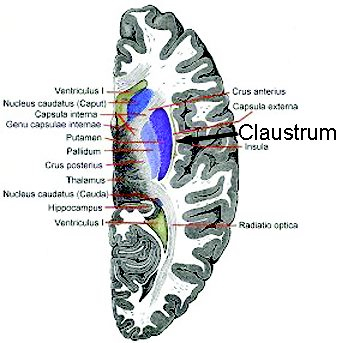What is the claustrum? The simple answer is that it’s a brain structure that lies under the insular and piriform cortices. What it does is rather unclear, but one hypothesis has drawn considerable attention. The claustrum contains projections to the entire cortex, and this may indicate that it plays an important role in brain function. But that role has been elusive. The hypothesis that has attracted attention is from the late, great Francis Crick. In his article with Christoph Koch (Crick and Koch 2005), it is proposed that the claustrum acts like a conductor of an orchestra, bringing together the disparate pieces to make something other than the cacophony of the orchestra warming up. They propose that the claustrum integrates the diverse inputs to make the sense “that underlie(s) conscious perception, cognition and action.” Perhaps this is the seat of consciousness?
Examination of the claustrum has not been easy. As Crick and Koch state: “It is very difficult to solely inactivate the claustrum by pharmacological substances or surgical ablation. Given its extended and sheet-like topography, ablating or otherwise shutting this structure down in a controlled manner—without interfering with fibres of passage or nearby regions—would require numerous, precisely targeted injections of the claustrum.”
Or perhaps targeting at the molecular level with targeted toxins. What is needed is array analysis of the cell-surface proteins that are expressed in the claustrum, followed by targeted toxins that would perform the suggested ablation. Koch, in his book The Quest for Consciousness, proposes the identification of the “neuronal correlates of consciousness” (Koch 2004), and states, “knowing where the neurons that mediate a specific conscious percept are located, where they project to and receive input from, their firing pattern, their developmental pedigree from birth to adulthood, and so on, might provide a…breakthrough on the way to a complete theory of consciousness.” Sounds like a job for targeted toxins.
And what happens if we see that the claustrum is the seat of consciousness? Well, insects have a claustrum, too. Do they have consciousness? There are lots of interesting questions in this project.
Crick, FC and C Koch (2005). “What is the function of the claustrum?” Philos Trans R Soc Lond B Biol Sci 360(1458):1271-9.
Koch, C (2004). The Quest for Consciousness. Englewood CO, Roberts and Company.

